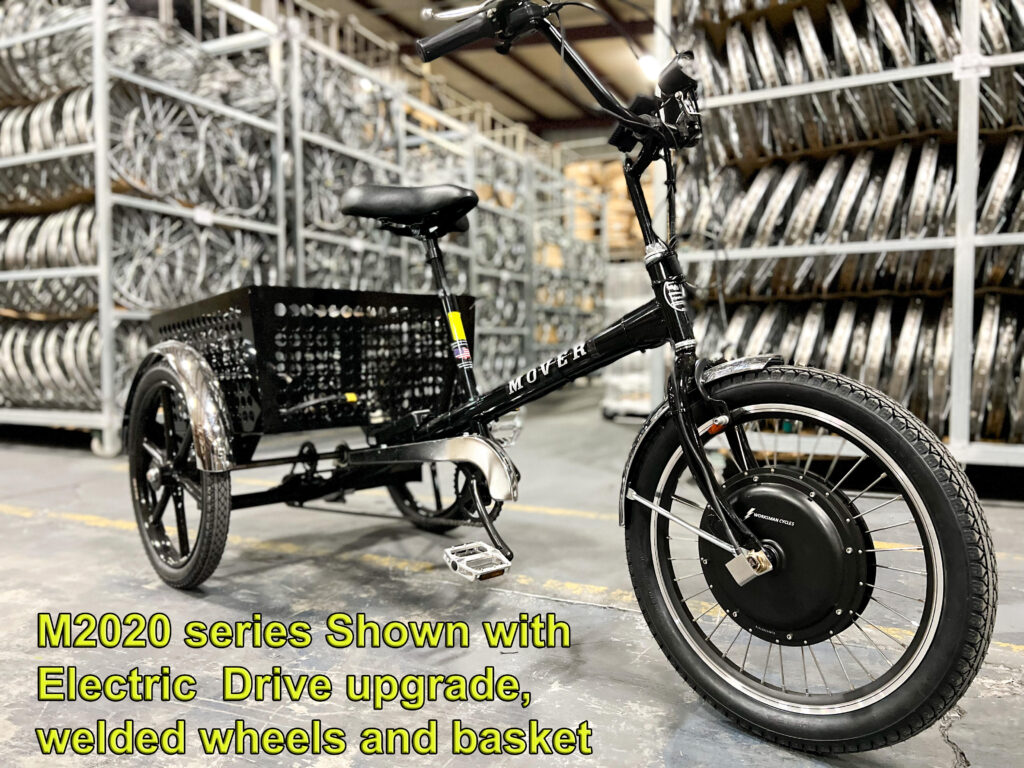Electric trikes are popping up everywhere. They’re fun, eco-friendly, and perfect for zipping around town.
But how do they actually work? Let’s break it down and explore the magic behind their efficiency. By the end, you’ll understand what makes these three-wheeled wonders tick.
What Is an Electric Trike?
An electric trike, or e-trike, is a three-wheeled vehicle powered by an electric motor. Think of it as a bicycle with an extra wheel and a motor that gives you a boost. It’s great for people who want a stable, comfortable ride without breaking a sweat.
E-trikes come in different styles, from cargo models for carrying groceries to sleek ones for cruising.
Why Choose an E-Trike?
E-trikes are stable because of their three wheels. They’re easier to balance than a regular bike, especially at low speeds.
Plus, they’re eco-friendly since they run on electricity instead of gas. They’re also cheaper to maintain than cars. For short trips or daily commutes, they’re a fantastic option.
Who Uses E-Trikes?
From seniors looking for a safe way to get around to delivery workers hauling packages, e-trikes appeal to many.
They’re also popular with people who want to exercise but need a little help on hills. Basically, anyone who wants a practical, fun ride can hop on an e-trike.
The Core Components of an Electric Trike
To understand how an e-trike works, let’s look at its key parts. Each component plays a role in making the trike move smoothly and efficiently.
The Motor: The Muscle
The electric motor is what drives the trike. It’s usually in the rear wheels or the front wheel hub.
When you twist the throttle or pedal (if it’s a pedal-assist model), the motor kicks in, pushing the trike forward. Motors range from 250 to 750 watts, with more powerful ones giving you better speed and hill-climbing ability.
The Battery: The Heart of the Trike
The battery powers the e-trike. Most e-trikes use lithium-ion batteries because they’re lightweight and hold a lot of energy. A fully Ascent batteries charge faster than older lead-acid ones, so you can get back on the road quicker.
Depending on the model, a fully charged battery can give you 20 to 60 miles of range. You recharge it by plugging it into a standard outlet, like charging a phone.
The Controller: The Brain
The controller is like the trike’s brain. It’s a small electronic box that manages the flow of electricity from the battery to the motor.
It ensures the motor runs smoothly and adjusts power based on how hard you’re pedaling or twisting the throttle. A good controller makes the ride feel natural and responsive.
The Throttle and Pedal-Assist System
Most e-trikes offer two ways to control the motor: a throttle or pedal-assist. The throttle is like a gas pedal—you twist it, and the motor gives you power instantly.
Pedal-assist, or PAS, senses when you’re pedaling and adds motor power to make it easier. Some trikes let you switch between modes, so you can choose what feels best.
Wheels And Tires
The wheels of an electric trike come in various sizes and designs, depending on the model. The tires provide traction and stability, crucial for a smooth and safe ride. Wheels and tires play a vital role in the overall performance of the trike.

Credit: www.reddit.com
How Does It All Come Together?
Now that we know the parts, let’s see how they work together. When you hop on an e-trike and start pedaling or twist the throttle, the controller sends electricity from the battery to the motor. The motor then spins the wheels, propelling you forward.
It’s that simple! The three-wheel design keeps you stable, even when you’re stopped or turning.
Let’s understand these key principles to help in grasping how an electric trike operates.
Electricity Conversion To Motion
In an electric trike, the electrical energy from the battery is converted into mechanical motion through the use of an electric motor.
The motor propels the trike forward by transferring electrical energy into rotational motion, which powers the wheels, thus allowing the trike to move.
Acceleration And Deceleration
Acceleration in an electric trike is achieved by controlling the amount of electrical current supplied to the motor, which increases the rotational speed of the wheels.
Deceleration, on the other hand, occurs through the reduction of electrical current to the motor, slowing down the rotational speed of the wheels, thereby reducing the speed of the trike.
Regenerative Braking
Electric trikes often employ regenerative braking systems, which function by converting the trike’s kinetic energy during braking into electrical energy to recharge the battery.
When the brakes are applied, the motor acts as a generator, capturing energy that would have been dissipated as heat in traditional braking systems, thus enhancing energy efficiency.
Efficiency Factors
When it comes to electric trikes, there are several efficiency factors that play a crucial role in their performance. Understanding these factors is essential in maximizing the efficiency and range of your electric trike.
In this section, we will delve into three important efficiency factors: Battery Capacity and Range, Motor Efficiency, and Weight and Aerodynamics.
Battery Capacity And Range
The battery capacity of an electric trike determines how much energy it can store to power the motor. A higher battery capacity means a larger amount of energy can be stored, allowing for longer rides without recharging.
The range of an electric trike refers to the distance it can travel on a single charge. It is influenced by various factors such as the battery capacity, motor efficiency, weight of the trike, and riding conditions.
Motor Efficiency
The efficiency of the motor is another crucial factor that impacts the performance of an electric trike.
A more efficient motor converts a higher percentage of electrical energy from the battery into mechanical energy, resulting in improved overall performance.
An efficient motor not only provides a smoother and more powerful ride but also increases the range of the trike.
Weight And Aerodynamics
The weight and aerodynamics of an electric trike also affect its efficiency. A lighter trike requires less energy to propel, allowing the battery to last longer and increasing the overall range.
Additionally, a trike with sleek and aerodynamic design reduces drag, allowing for smoother and more efficient rides. Manufacturers often focus on reducing weight and improving aerodynamics to enhance the overall efficiency and performance of electric trikes.
The Benefits of Riding an Electric Trike
E-trikes aren’t just about getting from point A to point B. They come with perks that make them a smart choice for many.
Eco-Friendly Transportation
E-trikes produce zero emissions while you ride. By choosing an e-trike over a car for short trips, you’re cutting down on air pollution and helping the planet. Plus, charging a battery uses way less energy than filling a gas tank.
Cost Savings
E-trikes are wallet-friendly. Charging a battery costs pennies compared to buying gas. Maintenance is also cheaper since e-trikes have fewer moving parts than cars. No oil changes or exhaust repairs here! Over time, the savings add up.
Health and Fun
Riding an e-trike is great for your body and mind. Pedal-assist modes let you exercise at your own pace, which is perfect for staying active without overdoing it. Plus, cruising around on an e-trike is just plain fun. The wind-in-your-hair vibe is hard to beat.
Challenges of Electric Trikes
No ride is perfect, so let’s talk about some e-trike downsides.
Batteries have a limited range, so you need to plan your trips. Charging can take a few hours, unlike a quick gas fill-up. E-trikes are also pricier upfront than regular bikes, with prices ranging from $1,500 to $5,000. Finally, they’re bulkier than two-wheelers, so storage and parking can be tricky in tight spaces.
Maintenance Tips
Keeping your electric trike in top condition ensures a smooth and safe ride. Regular maintenance is essential to prolong its lifespan and performance.
Here are some key maintenance tips to help you maintain your electric trike and keep it running efficiently for years to come:
Battery Care And Charging
- Proper care and charging of the battery are crucial for the optimal performance of your electric trike.
- Ensure to regularly inspect the battery for any signs of damage or corrosion. Clean the terminals and connections to prevent voltage drops.
- Charge the battery according to the manufacturer’s instructions and avoid overcharging, which can reduce its lifespan.
Motor And Controller Inspection
- Regular inspection of the motor and controller is vital to detect any issues early on.
- Check for loose connections, frayed wires, and any unusual noises during operation.
- Clean the motor to remove dirt and debris that could affect its performance.
- Inspecting and maintaining the controller will help prevent potential electrical failures.
Tire Pressure And Alignment
- Monitoring tire pressure and ensuring proper alignment is essential for a smooth and safe ride.
- Inspect the tires for any signs of wear and tear, and maintain the recommended pressure to optimize performance.
- Regularly check the tire alignment to prevent uneven wear and ensure stability during rides.
Tips for Getting the Most Out of Your E-Trike
Want to make your e-trike experience awesome? Here are some tips. First, keep your battery charged and store it in a cool, dry place to make it last longer.
Second, check your tire pressure often—properly inflated tires improve efficiency and range. Third, use pedal-assist mode when you can to save battery life.
Lastly, follow local e-trike laws, like speed limits and helmet rules, to stay safe.
Comparison With Traditional Trikes
An electric trike operates differently compared to a traditional trike. Let’s explore the key differences in terms of performance, cost, and carbon footprint.
Performance Differences
Electric trikes provide smoother acceleration and enhanced stability. They offer easier maneuverability and reduced physical exertion compared to traditional trikes.
Cost Analysis
Electric trikes may have a higher upfront cost but are more cost-effective in the long run due to lower maintenance and operational expenses. Traditional trikes tend to require more frequent repairs and replacements.
Carbon Footprint Comparison
Electric trikes are environmentally friendly with zero emissions, contributing significantly less to air pollution compared to traditional trikes that rely on fossil fuels. They help in reducing carbon footprint and promoting sustainable transport options.
Future Of Electric Trikes
Electric trikes operate using a battery-powered motor to assist in pedaling and provide a smoother ride. The future of electric trikes looks promising with advancements in technology enhancing their efficiency and eco-friendly nature. Riders can enjoy a convenient and sustainable mode of transportation with these innovative vehicles.
Technological Advancements
Electric trikes are rapidly evolving with cutting-edge technology like regenerative braking systems.
Market Trends
The market for electric trikes is growing exponentially due to increasing demand for sustainable transportation options.
Urban Mobility Solutions
Electric trikes are becoming a popular solution for urban mobility challenges, offering eco-friendly and efficient transportation.
Electric trikes are revolutionizing the way we think about sustainable transportation. They are not only environmentally friendly but also provide a convenient mode of travel for individuals of all ages. Let’s explore the exciting developments shaping the future of electric trikes.
Frequently Asked Questions
What Are The Disadvantages Of An Electric Tricycle?
Electric tricycles have limited speed and range, and they may be heavier and bulkier compared to traditional bikes.
Do You Pedal An Electric Trike?
Yes, you can pedal an electric trike for additional exercise or when the battery runs out.
What Is The Difference Between An E-bike And An E-trike?
An e-bike is a two-wheeled electric bicycle, while an e-trike is a three-wheeled electric tricycle.
Do Electric Bikes Go Without Pedaling?
Electric bikes can go without pedaling. They have a motor that provides power to propel the bike forward, making it easier to ride. However, most electric bikes still require some level of pedaling to activate the motor and increase the speed.
Conclusion
The functioning of electric trikes involves the integration of a battery-powered motor to assist with pedaling. The innovative design and technology behind electric trikes offer a convenient and eco-friendly mode of transportation for individuals of all ages.
Understanding the mechanics of electric trikes can enhance their appeal and contribute to greater usage in the future.




